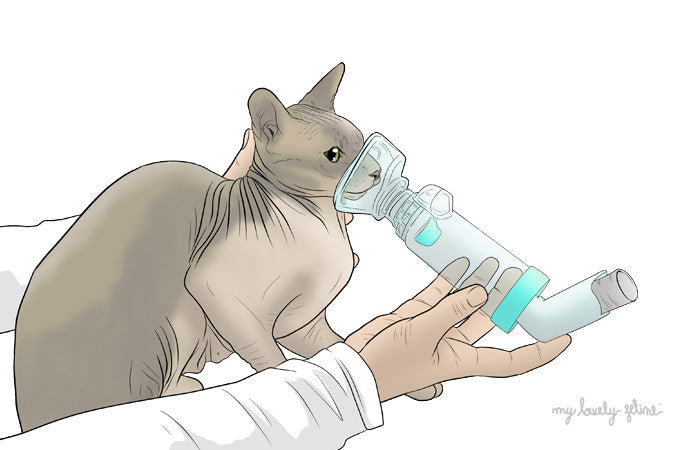—Veterinarian 🇺🇸
|
Many people haven’t heard of cats getting asthma. Asthma in cats is fairly different from asthma in people, however, there are some similarities. Feline asthma is most similar to COPD in humans. In this article I am going to explain everything you need to know about this disease including how to identify it and how to treat it! |
What is feline asthma?
Feline asthma affects a small to moderate amount of cats. By definition, asthma is an inflammation of the airways that is associated with increased responsiveness to certain inhalants, narrowing of the airways, and inflammatory cells in the airways.
Cats commonly also have bronchitis in conjunction with asthma. Bronchitis is the coughing and/or wheezing that comes from inflammation in the lower airway. Asthma and bronchitis are typically considered as two parts of the same syndrome.
This syndrome may also be referred to as chronic obstructive pulmonary disease (COPD).
Cats with asthma have airways that are sensitive to certain inhalants. Consequently, exposure to these inhalants can cause an inflammatory response leading to bronchial spasms, increased mucus production, and accumulation of mucus in the airways.
Inability to clear the bronchi of mucus can lead to airway obstruction and may leave the cat susceptible to secondary respiratory infections. Chronic airway obstruction may trap air in the tiny lung passages called alveoli, leading to over-inflation and lung damage.
Coughing and respiratory distress (difficulty breathing, shortness of breath, and open-mouth breathing) are the most common signs of feline asthma and bronchitis.
Coughing is a significant finding since there are relatively few causes of coughing in cats. Coughing cats assume a squatting position with their necks extended. These cats will also generally wheeze.
FAQ
Are some cats more likely to get asthma?
This disease is most commonly diagnosed in cats from 1-8 years of age, however, this doesn’t necessarily mean cats in this age range are more likely to get the disease. Siamese cats seem to be at higher risk for developing this disease. Overweight cats are also at greater risk for developing chronic respiratory disease.
What causes feline asthma and bronchitis?
The actual cause of the inflammation associated with feline asthma and bronchitis is unknown. Cats with asthma are commonly reactive to or triggered by:
- Dust from cat litter
- Cigarette smoke
- Perfume
- Candles
- Hairspray
- Carpet cleaners
- Air fresheners
- Scented laundry detergent and/or fabric softeners
- Mold/mildew
- Essential oil diffusers
What are the signs of asthma and bronchitis?
The most common reason people bring their cats in for those who are diagnosed with asthma is chronic coughing. The cough is usually 'dry' or harsh, and gagging is common after coughing. It can appear similar to coughing up a hairball without the production of one.
If not caught early, the disease may progress and cat owners may notice respiratory difficulty. Breathing may become noisy, and the pet may wheeze when exhaling.
How is asthma diagnosed?
Asthma is what we call “a diagnosis of exclusion.” This means there is no specific test for asthma-we just have to rule out other similar diseases such as pneumonia, heartworm disease , primary lung parasites, and cancer.
Recommended diagnostic tests typically include a complete blood count (CBC), blood chemistries, fecal exam, chest x-rays, heartworm test, +/- bronchoscopy and tracheal lavage.
One type of white blood cell, the eosinophil, is commonly associated with allergic events or parasitic disease and its presence supports a tentative diagnosis of asthma. Elevated blood proteins also occur in some affected patients.
How is asthma treated?
The most important thing to recognize, is that asthma is treated, NOT CURED. Treatment is typically lifelong and the goal is to minimize symptoms.
- Avoiding triggers. This means trying different brands of cat litter, eliminating cigarette smoke from the home, minimizing any dust build up and using air filters/purifiers etc.
It is important to pay close attention to environmental factors that may aggravate or worsen the condition. - Weight loss
-
Corticosteroids. Corticosteroids have potent anti-inflammatory effects and can provide relief to cats experiencing the respiratory distress of asthma and bronchitis. Unfortunately, there are many side effects to steroids.
The goal with steroid treatment is to taper your cat down to the lowest effective dose without causing side effects. If oral steroids are effective, your veterinarian may recommend switching to inhaled steroids to minimize side effects. Inhaled steroids are unfortunately very expensive.
- Bronchodilators are sometimes added for cats in which steroids aren’t enough to control their symptoms.
- Acupuncture can be helpful as well, in some cases.
Conclusion
Feline asthma is a semi-common disease in cats. It is diagnosed by ruling out other common diseases that present similarly. Cats with this disease typically initially present to their veterinarian with coughing or wheezing as their main complaint.
Treatment is typically lifelong but manageable. Many asthmatic cats go on to live long happy lives. If you think your cat has asthma, please take him/her to their veterinarian.
Article by Dr. Kimberly Couch 👩⚕️
Veterinarian



